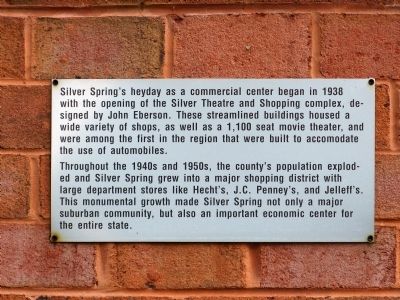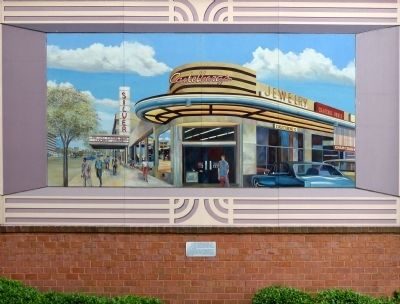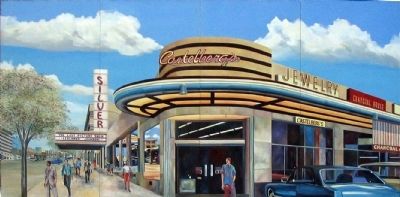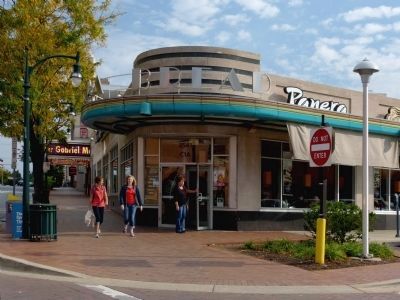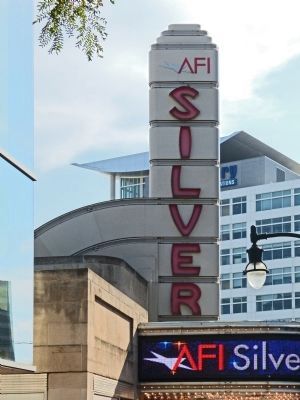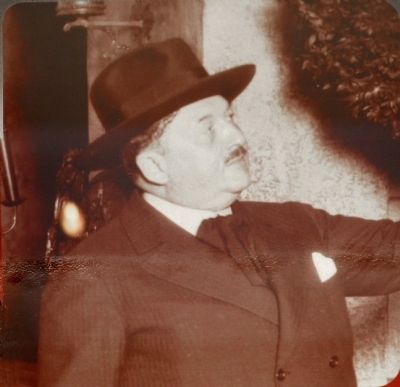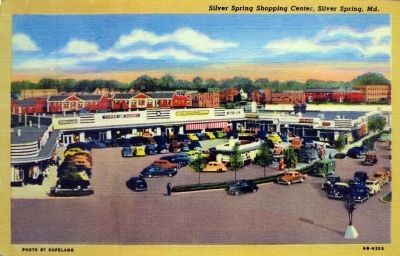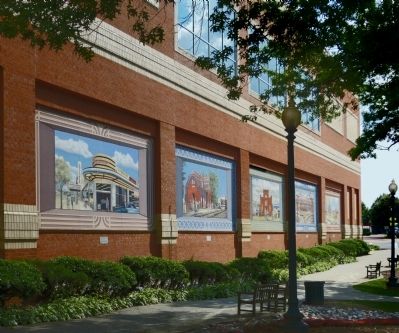Downtown Silver Spring in Montgomery County, Maryland — The American Northeast (Mid-Atlantic)
Silver Spring Shopping Center
Throughout the 1940s and 1950s, the county's population exploded and Silver Spring grew into a major shopping district with large department stores like Hecht's, J.C. Penney's and Jelleff's. The monumental growth made Silver Spring not only a major suburban community, but also an important economic center for the entire state.
Topics. This historical marker is listed in this topic list: Industry & Commerce. A significant historical year for this entry is 1938.
Location. 38° 59.37′ N, 77° 1.733′ W. Marker is in Silver Spring, Maryland, in Montgomery County. It is in Downtown Silver Spring. Marker is on Newell Street. Marker is in Acron Park on the Wall of the Discovery Communications Building, formerly Caldor. Touch for map. Marker is at or near this postal address: 8060 Newell Street, Silver Spring MD 20910, United States of America. Touch for directions.
Other nearby markers. At least 8 other markers are within walking distance of this marker. Silver Spring Armory 1914 (a few steps from this marker); The Silver Spring (a few steps from this marker); Silver Spring B & O Railroad Station (a few steps from this marker); The Community of Silver Spring (within shouting distance of this marker); Early's Raid on Washington (within shouting distance of this marker); Blair House (within shouting distance of this marker); Canada Dry Building (within shouting distance of this marker); Blair Mansion: Silver Spring / Blair Station Post Office (within shouting distance of this marker). Touch for a list and map of all markers in Silver Spring.
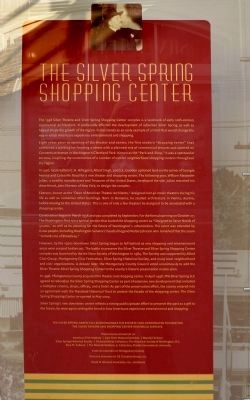
Photographed By Allen C. Browne, October 5, 2013
8. Silver Spring Shopping Center Sign
The 1938 Silver Theatre and Silver Spring Shopping Center complex is a landmark of early 20th-century commercial architecture. It profoundly affected the development of suburban Silver Spring as well as helped shape the growth of the region. It also stands as an early example of a trend that would change the way in which Americans experience entertainment and shopping.
Eight years prior to opening of the theater and center, the first modern "shopping center" that combined a parking lot fronting a street with a planned mix of commercial tenants was opened on Connecticut Avenue in Washington's Cleveland Park. Known as the "Park-and-Shop," it was a spectacular success, inspiring the construction of a number of similar neighborhood shopping centers throughout the region.
In 1936, local realtors C.H. Hillegeist, Albert Small, and S.E. Godden optioned land on the corner of Georgia Avenue and Colesville Road for a new theater and shopping center. The following year, William Alexander Julian, a wealthy manufacturer and Treasurer of the United States, developed the site. Julian recruited his close friend, John Eberson of New York, to design the complex.
Eberson, known as the "Dean of American Theater Architects," designed over 40 movie theaters during his life as well as numerous other buildings. Born in Romania, he studied architecture in Vienna, Austria, before moving to the United States. This is one of only a few theaters he designed to be associated with a shopping center.
Construction began in March 1938 and was completed by September. For the formal opening on October 27, The Washington Post ran a special section that touted the shopping center as Designed to Serve Needs of 50,000," as well as its planning for the future of Washington's urbanization. The event was attended by 6,000 people, including Washington Senators' baseball legend Walter Johnson who remarked that the scene "reminds me of Broadway."
However, by the 1970s downtown Silver Spring began to fall behind as new shopping and entertainment areas were created further out. The battle to preserve the Silver Theatre and Silver Spring Shopping Center complex was launched by the Art Deco Society of Washington in 1984. The Society was supported by Allied Civic Group, Montgomery Civic Federation, Silver Spring Historical Society, and many local neighborhood and civic organizations. A decade later, the Montgomery County Council voted unanimously to add the Silver Theatre-Silver Spring Shopping Center to the county's historic preservation master plan.
In 1996, Montgomery County acquired the theater and shopping center. In April 1998, PFA Silver Spring LLC agreed to redevelop the Silver Spring Shopping Center as part of extensive new development that included a multiplex cinema, shops, offices, and a hotel. As part of the preservation effort, the county entered into an agreement with the Maryland Historical Trust to protect the facade of the shopping center. The Silver Spring Shopping Center re-opened in May 2004.
Silver Spring's new downtown center reflects a strong public/private effol1 to preserve the past as a gift to the future, by once again setting the trend in how Americans experience entertainment and shopping.
Eight years prior to opening of the theater and center, the first modern "shopping center" that combined a parking lot fronting a street with a planned mix of commercial tenants was opened on Connecticut Avenue in Washington's Cleveland Park. Known as the "Park-and-Shop," it was a spectacular success, inspiring the construction of a number of similar neighborhood shopping centers throughout the region.
In 1936, local realtors C.H. Hillegeist, Albert Small, and S.E. Godden optioned land on the corner of Georgia Avenue and Colesville Road for a new theater and shopping center. The following year, William Alexander Julian, a wealthy manufacturer and Treasurer of the United States, developed the site. Julian recruited his close friend, John Eberson of New York, to design the complex.
Eberson, known as the "Dean of American Theater Architects," designed over 40 movie theaters during his life as well as numerous other buildings. Born in Romania, he studied architecture in Vienna, Austria, before moving to the United States. This is one of only a few theaters he designed to be associated with a shopping center.
Construction began in March 1938 and was completed by September. For the formal opening on October 27, The Washington Post ran a special section that touted the shopping center as Designed to Serve Needs of 50,000," as well as its planning for the future of Washington's urbanization. The event was attended by 6,000 people, including Washington Senators' baseball legend Walter Johnson who remarked that the scene "reminds me of Broadway."
However, by the 1970s downtown Silver Spring began to fall behind as new shopping and entertainment areas were created further out. The battle to preserve the Silver Theatre and Silver Spring Shopping Center complex was launched by the Art Deco Society of Washington in 1984. The Society was supported by Allied Civic Group, Montgomery Civic Federation, Silver Spring Historical Society, and many local neighborhood and civic organizations. A decade later, the Montgomery County Council voted unanimously to add the Silver Theatre-Silver Spring Shopping Center to the county's historic preservation master plan.
In 1996, Montgomery County acquired the theater and shopping center. In April 1998, PFA Silver Spring LLC agreed to redevelop the Silver Spring Shopping Center as part of extensive new development that included a multiplex cinema, shops, offices, and a hotel. As part of the preservation effort, the county entered into an agreement with the Maryland Historical Trust to protect the facade of the shopping center. The Silver Spring Shopping Center re-opened in May 2004.
Silver Spring's new downtown center reflects a strong public/private effol1 to preserve the past as a gift to the future, by once again setting the trend in how Americans experience entertainment and shopping.
Credits. This page was last revised on May 25, 2023. It was originally submitted on August 5, 2014, by Allen C. Browne of Silver Spring, Maryland. This page has been viewed 649 times since then and 38 times this year. Photos: 1, 2, 3, 4, 5, 6, 7, 8, 9. submitted on August 5, 2014, by Allen C. Browne of Silver Spring, Maryland. • Bill Pfingsten was the editor who published this page.
